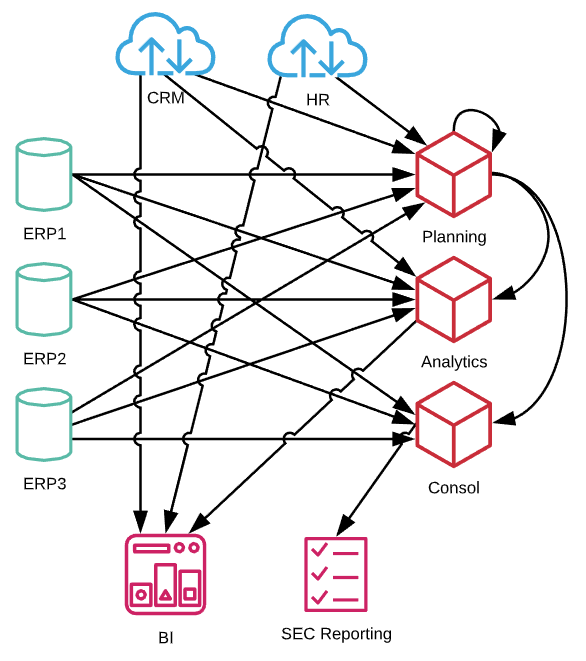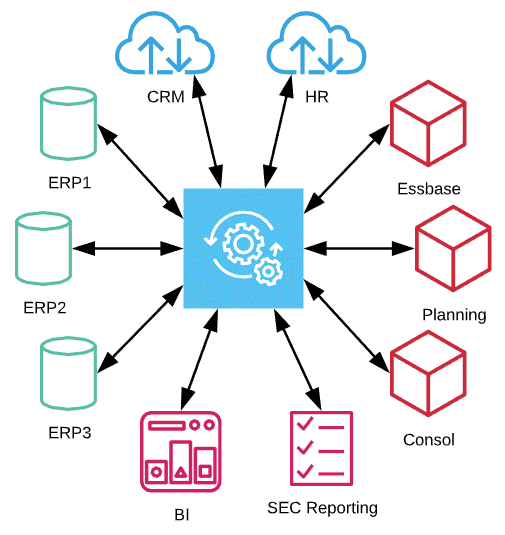| Summary: | This article describes a concept that Finance & Digital Transformation teams can and should leverage to build a foundation for growth – for EPM and beyond. It is a proven success factor for building a foundation for growth that will help EPM teams broaden the scope of their applications without experiencing growing pains. Read this post to find out what this concept is all about. |
In the previous post, we saw how integration challenges arise as an EPM environment evolves over time. In this post, you will learn how to avoid these growing pains. At the center of this discussion is a concept that has been proven for decades in large data management environments. It solves a large number of EPM integration challenges very elegantly and effectively. The purpose of this series is to explain the underlying architecture of this concept. This solution is a generic approach that can be applied to all EPM/CPM solutions on the market.
With Finance teams expanding their scope beyond just EPM, this can be extended to all Finance Transformation / Digital Transformation initiatives as well.
A personal note: this topic is one of my favorites. Based on my experience, the approach we will discuss is not commonly used within the EPM community – yet! It is very valuable and important, especially as the importance of EPM environments is increasing. This will be a cornerstone article for this blog series as there are so many best practices and concepts associated with it.
Data Flows WITHOUT a Foundation for Growth
As we’ve seen in the previous article, there are many challenges for EPM integration as environments grow over time. A complicated mesh of processes is typically the outcome of organically growing processes. When a project starts, the need for a foundation is often not obvious yet and the project team can realize several quick wins without a strategy in place. However, this certainly changes over time. This has a significant impact on various aspects of managing EPM environments:
- Development: need to “reinvent the wheel” over and over due to the lack of a standard development process based on reusable building blocks. This requires a lot of rework and/or duplicated efforts with small or large tweaks.
- Operations: need to maintain multiple processes with potentially very different implementation approaches despite having a very similar purpose. This results in unnecessary errors due to rash or accidental actions.
- Knowledge Transfer: getting new employees up to speed is a lot harder. Different implementation approaches not only cause confusion, but also raise questions about the quality of the built processes. This is a specially true for small teams which rely on a small number of key people.
- Change Management: migrating process artifacts is complex, the number of processes is increasing, UAT and regression testing require addressing many more test cases.
- Security: as organizations are adopting more and more cloud applications, it is crucial to ensure access is managed securely.
- Data Consistency: transferring the same data set between applications multiple times often results in discrepancies due to timing.

Data Flows WITH a Foundation for Growth
Now that we’ve described the problems in detail, let’s discuss how we can build a foundation for growth. There are so many advantages when an EPM team invests the time to develop an EPM integration strategy – and this is actually not a big investment of time.
In contrast to data flows without a foundation for growth (see above), here is a short list of the improvements that organizations can expect:
- Development: new integration processes follow an existing blueprint. This framework allows reuse of existing data sets, metadata, mappings and other building blocks to expedite build activities.
- Operations: all processes follow the same data flow and provide the same type of logging. Mechanisms to manage data, metadata, mappings and accuracy are consistent across all processes.
- Knowledge transfer: new team members only need to understand the core components of their organization’s blueprint. Once that is accomplished, they can apply this approach quickly to the existing processes.
- Change Management: the number of new artifacts grows a lot slower. Changes to existing artifacts are infrequent and focus on new development activities. UAT and regression testing are reduced because changes are incremental and therefore minimal.
- Security: access can be managed in a central place. Developers and security teams only need to focus on one access point to their sensitive cloud applications. There are no loopholes or forgotten security policies that open vulnerabilities.
- Data Consistency: access to source data is controlled and admin teams can eliminate the risk for discrepancies due to “timing issues”.
So what is this concept that has so much value for Finance and Digital Transformation professionals, working with EPM/CPM and beyond?!
A Clean and Proven Solution: Hub & Spoke Architecture
At the beginning of my career I used to work with Business Intelligence and Data Warehouse solutions. One of the most important concepts I learned about during this time is the Hub & Spoke Architecture. There is no way to manage a data warehouse without the proper foundation. With EPM, there is more wiggle room – at least in the early stages and for very small environments. However, as mentioned above, this is really just a matter of time as your environment keeps growing.
The term “Hub & Spoke” as an analogy to a bicycle wheel: the hub is in the middle (and all data sets flow through here) and the spokes are connecting it to the rim (the various applications surrounding it). There is no direct connection between the various applications, but all data movements are passing through the hub.
Here is a quick summary of the Hub & Spoke Architecture, based on an article from The Data Warehouse Institute (TDWI):
The Hub & Spoke Architecture is a pattern that serves as a proven standard for development activities. This results in simplicity for building integrations as these processes are consistent and can be reused. The idea is that the bulk of the processes will follow this clearly defined approach. However, there is always room for point-to-point interfaces which can complement the Hub & Spoke architecture.
The main benefits for EPM teams are:
- A flexible, clearly defined architecture
- The ability to reuse processes and data
- A reduction in the number of integrations
- Faster development activities
- Simplified maintenance as all integrations follow a common approach
Here is an example of how the Hub & Spoke Architecture simplifies complex processes: the data flow diagram for EPM applications and their boundary systems is clean, easy to follow and extensible. Compare the following diagram to the one above without an integration strategy:

Why is this important for EPM?
In the beginning of this article, I mentioned that it doesn’t seem like the Hub & Spoke architecture is well known within the EPM community. I see two main reasons for this: first, the data management requirements of EPM projects are not as complex as data warehouses; second, similar concepts are implemented in solutions like FDMEE, although on a much smaller scale.
Do you absolutely need to build a foundation for growth? No, it is not absolutely required, but medium to large business customers that we’ve worked with over the last decade have seen dramatic improvements. Having a foundation for growth in place has resulted in cost and time savings of more than 70%. Hence, organizations get done much more – with a lot less effort.
Along those lines, the FinTech team is convinced that EPM teams and their business users will experience drastic improvements if they have a strategy in place. This is based on our experience from many EPM projects across various industries for more than 10 years:
- Implementing EPM solutions which are easy to maintain despite complex requirements
- Helping customers by assessing their existing environments based on proven methods
- Providing recommendations on how to simplify their existing processes
Conclusion
The Hub & Spoke Architecture provides very important guidelines for building a foundation for growth. This concept has been proven in the most complex data management projects. EPM teams who adapt this approach will see significant improvements in managing their data.
As mentioned in the original article about how to “Avoid Growing Pains with an EPM Integration Strategy”, the purpose of this blog series is to prepare you for the long run. Throughout this blog series, we will explain how to leverage this concept to build a foundation for growth.
Stay tuned for the next article – and please share your thoughts in the comments below.
In the meantime, please follow us on LinkedIn and find out more about FinTech’s Integration & Automation Platform ICE Cloud. Let’s make EPM Integration and Automation easy!
